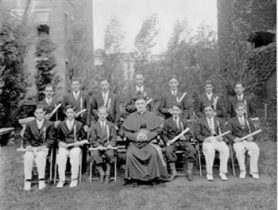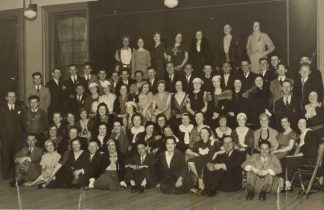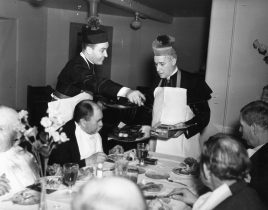
Courtesy of the Archives of the Archdiocese of Newark at Seton Hall University
Monsignor John G. Delaney succeeded Monsignor Quirk as pastor in 1932. He also served as secretary to Bishop Walsh and Moderator of Mount Carmel Guild. Delaney’s report to the diocese in 1933 gives us a snapshot of St. Patrick’s in the 30s. It was a parish with over 3,500 members, including 700 families. No longer were they predominantly Irish-American. Almost half were of Italian origin. Monsignor Delaney gave great attention to Italians, his solicitude in contrast to some pastors who sent Italians and other immigrants to the “national” parishes. In the Sunday School catechetical and sacramental preparation classes, the overwhelming majority of the children were Italian. In addition to a handful of German, Polish, Spanish, and French parishioners, Delaney counted 19 “Colored” families. The migration of African Americans from the southern states had begun. St. Patrick’s was already sensitive to their spiritual needs. That year 31 couples were married and 79 persons baptized, ten of whom were converts. Delaney estimated confessions at 2,000 per week and communions at 83,000 per year. Sunday Masses drew 3,100 and holy day Masses 5,000.
Sunday devotions to the Sacred Heart attracted 500, and First Friday devotions to the Little Flower attracted 2,200 each month. Lenten devotions brought 3,500 to church; the novena to St. Joseph, 4,500; to the Immaculate Conception, 5,000; the triduum for the Holy Souls, 2,000. May, June, October and November devotions each attracted 2,000. For city people these activities were an opportunity for prayer and socialization. The parish was the center not only of spiritual life but was a place where people mingled several times a week.

St. Patrick’s Dramatic Club — 1933
Courtesy of Rita Shaw
Parish organizations were vibrant. In St. Patrick’s the Holy Name Society counted 225 members; the Rosary Society, 150; the Children of Mary, 175; the League of the Sacred Heart, 2,000; the Altar Society,150; the Propagation of the Faith, 200; and the Cathedral Catholic Club, 200. The Annual Holy Name Society May Communion Breakfast was hosted by the women of the parish who prepared an elaborate meal in the school hall. This event drew several hundred men, some of them not members of the society. Parishioners who recall the event believe that the high quality of the breakfast was a major attraction. A new parish organization was formed soon after Monsignor Delaney’s arrival, the “St. Patrick’s Dramatic Club.” Its first endeavor, College Daze, was presented at the West Side High School auditorium in 1933, directed by Edward Stanley. Necessary props, including football equipment, were supplied by Saint Peter’s College in Jersey City.
To coordinate these activities, Monsignor Delaney relied on his assistant pastors. Their duties were clearly spelled out by Delaney.
General Duties of Cathedral Priests
Father Lenihan will have charge of the School and the Children of Mary.
Father Colrick will have the Altar Boys, the Rosary society, the Mount Carmel Guild Catechetical classes made up of the children of the parish who attend the Public Schools, and will arrange four parish suppers a year — January, March 17, June and September.
Father Kenney will be in charge of the Cathedral Club, the Junior and Senior Holy Name Society, will be in charge of the bazaar in October, and conduct the weekly card parties.
One priest will be on Sick Call and parlor duty every week, and will see each person who comes in regardless of whom they ask for.
One priest will be on Devotion Duty every week.
One priest will be free of these duties except when he substitutes for the other two on their day off.
Devotion duty is taking charge of the prayers and hymns (Sermons) at all week day Noon Masses, and conducting all week night devotions.

Courtesy of the Archives of the Archdiocese of Newark at Seton Hall University
The assistants were also required to take care of Catholics at the Newark Eye and Ear Infirmary, St. Michael’s Hospital, Newark Jail, and the House of Detention. The Newark Eye and Ear Infirmary was located on Central Avenue, across from the School. Its site now serves as the parking lot of the Newark Museum. The priests made rounds in the infirmary every day and enjoyed an excellent rapport with doctors, nurses, and patients. Many of these medical professionals attended an annual Mass held in the pro-cathedral in May to honor those dedicated to health care. Given these personal links, it is not surprising that, after the Archdiocesan Deaf Association was formed in 1940, St. Patrick’s School Hall was the site of dances sponsored by the association.
Delaney directed the ushers with similar precision, publishing detailed rules for them to follow.
Rules for Ushers
5. At the 12:30 Mass each Sunday, two men will be at each door, one to stand at the box and to use all possible moral suasion to induce the faithful to drop two nickels in the box for seat money, the other usher will be supplied with $20, in cash each Sunday, and he will make change for seat money.
7. When Mass begins, the ushers are to be in the Church, and not celebrate old home week in the vestibule.
The October 1929 crash of the New York Stock Exchange plunged the United States into the deepest financial depression in its history. In 1929 St. Patrick’s Parish income was almost $90,000. In 1933 it dropped to $52,000. Parishioners struggled to maintain activities while giving aid to those less fortunate. The record is impressive. Addressing parish societies in 1934, Monsignor Delaney remarked that “During the past year thanks to your charity, children who were undernourished received 33,159 meals and $2,400 was contributed to the poor.”
The Ledger of the St. Vincent de Paul Society for the first six months of 1932 lists 547 persons given assistance and $2,390 paid out. Assistance took the form of purchasing shoes, paying life insurance bills, gas bills, room rent, providing furniture, and obtaining jobs. The records mention several Spanish names among the recipients. Spanish-speaking parishioners, who later would constitute an important part of the parish, were already present in the 1930s. Some had come from the Canary Islands in the 1920s and others arrived throughout the 1930s. Many had fled the Civil War that ravaged Spain during these decades.
Statistics give only bare figures. Excerpts from letters to Monsignor Delaney tell poignant stories of desperation in the 1930’s:
- Just paid my last sent (sic) out for room rent Saturday 3 dollars.
- Thank you for what you have done to feed my children.
- I will pay you back.
- I have nothing to eat tonight or for lunch tomorrow.
- I want to ask you if you will see if I can get a Christmas basket. I have a cripple husband too if you dont (sic) believe me you can send any body over.
Another letter clearly shows the pain and hope of the era.
Dear Monsignore,
I have been placed in a temporary job at the Montgomery baths, am not sure for how long a time it will last or just what the pay is, understand eighty dollars a month, pay twice a month, of course. I will have nothing coming just yet as I only started on Thursday.
This is to thank you, Monsignore, for your kindness to me. The orders for groceries came just in time to save us and are the means of continuing the nourishment our boys are used to, we do appreciate it so, and if the time ever again comes that we have some money, meaning a salary coming in we will not forget your kindness, we will help the Guild by trying to pay back as much as we can and more if we have it, so that it will continue to be able to help others in need as it is taking care of us, we do not know what would have happened only for you.
As you know, Monsignore, what I want is a permanent job and if you can help me in securing one with Mr. Sinnott or anyone, a job that I am competent of doing you know I will appreciate it.
Will pray for you and have our boys pray for you always, you have been so good and kind.
Thank you, Monsignore,
Frank H. Ward
During the Depression, St. Patrick’s opened a “soup kitchen” that dispensed hot lunches for the needy. Volunteers worked in the school basement preparing gallons of soup in huge cauldrons. Hundreds of men lined up in the school playground waiting for their one hot meal of the day. The Sisters showed compassion and tact as they instructed youngsters that “The men are very busy. Do not bother them.” Although donations from parishioners were essential to its running, the soup kitchen was also aided by contributions from Protestant and Jewish friends of Monsignor Delaney. Among the donors was Abner “Longy” Zwillman of West Orange, a reputed member of the underworld. Zwillman was also generous to the Mount Carmel Guild, headed by Delaney.

Courtesy of the Archives of the Archdiocese
of Newark at Seton Hall University
Parish spirits in these hard times were lifted with the establishment of the “St. Patrick’s Fife, Drum and Bugle Corps.” Marching with a color guard, they became a source of pride to the parish. The Corps provided discipline, recreation and skills for many of the young of the parish. Resplendent in green and gold uniforms, they won numerous prizes in competitions. Unfortunately, the corps was disbanded 20 years later. Somehow, in the midst of the Depression, the parish managed to help its families pay high school tuition and continued its generosity to needy parishes, giving $750 to “Queen of Angels Colored Mission” in 1936. Monsignor Delaney was personally generous, sending a Passionist missionary “$10.00 to buy yourself a box of cigars in appreciation for the splendid services rendered at St. Patrick’s Cathedral on Good Friday.”
The school and the youth of the parish were not neglected. St. Patrick’s sponsored Girl Scout Troop 69, later Troop 379, and Boy Scout Troop 54. The Girl Scouts were organized in 1941 under the direction of Rose Corcoran, Eleanor Walsh and Miss Quigley. Leadership passed to Mary McDonough, Marie Brodeur and Rosemarie Brodeur. Robert Flatley headed the Boy Scout troop. Together with Bowling Leagues and other sports activities, they provided wholesome recreation for young people.
A new venture of Monsignor Delaney involved a cooperative effort between St. Patrick’s and Seton Hall College. Almost a century earlier, Father McQuaid had served as pastor of St. Patrick’s and President of Seton Hall. Now, Seton Hall was coming to St. Patrick’s, renting the school for classes. This made it convenient for parishioners and others in the area to pursue a college degree without travel. Seton Hall paid for renovations to the school so both profited from the arrangement. The chairs and desks of the elementary school were too small for the much larger collegians so Seton Hall provided larger furniture. Beginning in 1937 Seton Hall enrolled 524 students in 37 different courses, including English, Latin, Education, Math, History, Sociology, Business Administration, Philosophy, Modern Languages, and Natural Science. Included among the students were sisters seeking degrees that would improve their teaching skills. These courses continued for several years until Seton Hall moved into a more permanent building in Newark.
The parishioners took such pride in their church that, even in these hard times, they saw to its refurbishing. The roof was replaced and new oak vestment cases were installed in the sacristy. Four confessionals were replaced at a cost of $300 each. Donors provided 46 sets of vestments for ordinations at $25 per set. More than 1,000 books were donated for the many popular devotions regularly held at the pro-cathedral. The year 1941 was filled with activity. It opened with a card party and dance at The Mosque Theater, now Newark Symphony Hall, in January. Each Sunday in Lent the Cathedral Dramatic Society performed the passion play, The Upper Room. Lenten fast was interrupted by the St. Patrick’s Day Supper in March. In April there was a two-night talent show, in May a Spring Festival, and a Parish Supper in June. After summer, another Parish Supper was held in September, a Parish Show in October, a two-night bazaar in November, and a minstrel show in December.
On December 7, 1941, the “date that will live in infamy,” the United States entered World War II. Many sons of the parish went off to fight in Europe or the Pacific. Young women entered the military as well. Servicemen going overseas came to the school for a farewell visit to the sisters. The sisters encouraged the students of St. Patrick’s to be “pen pals” for the parish’s soldiers and sailors. Throughout the war, the youngsters kept in contact with servicemen, reminding them they were not forgotten and were in the prayers of friends at home. The millions of men going overseas combined with the industrial demands of the war effort brought women into the workforce in great numbers. During the war, St. Patrick’s prayed for the safe return of loved ones and wept at Masses for those who lost their lives. When peace returned, everyone hoped for a return to “normalcy.”
« World War and the “Roaring Twenties” | Storms and Celebrations — The Forties and Fifties »